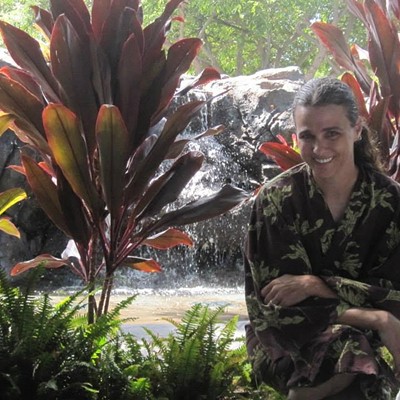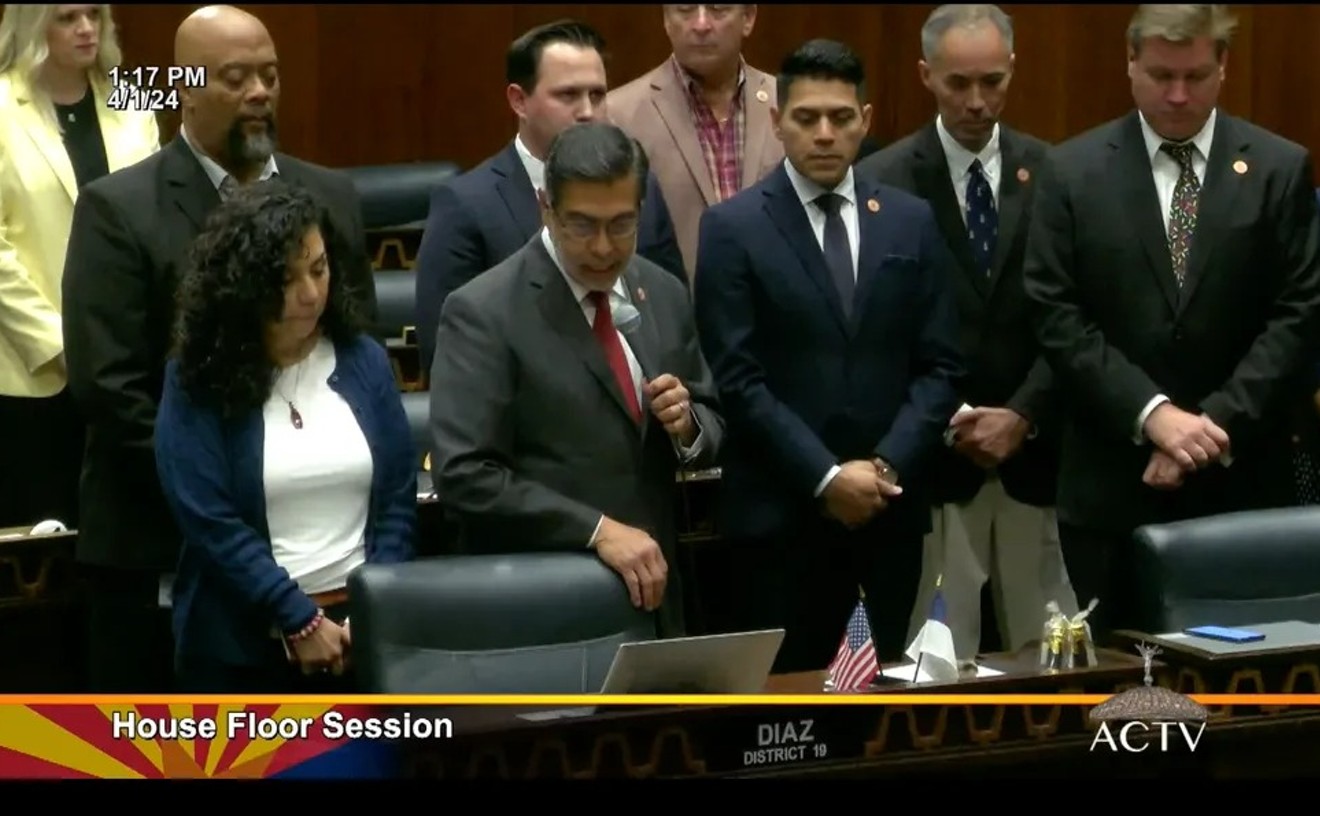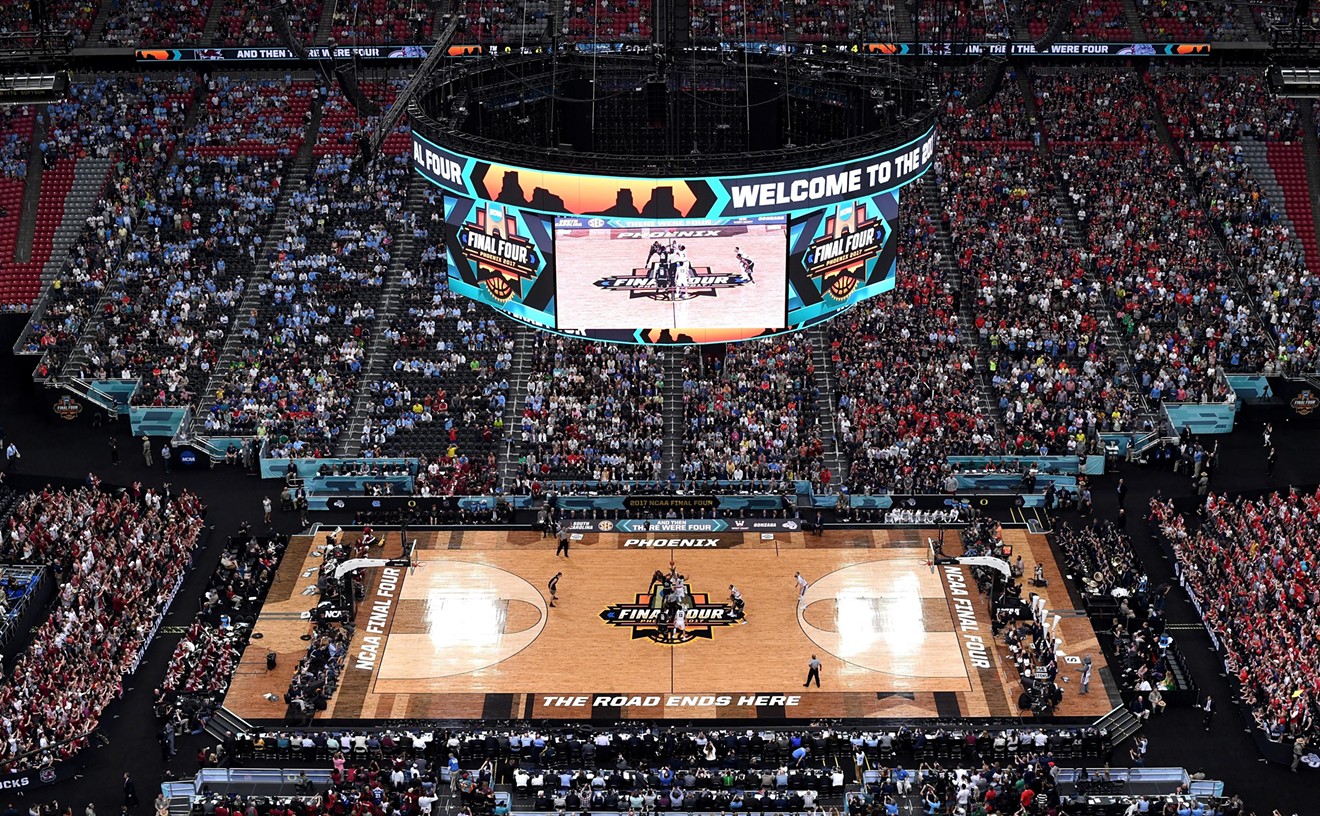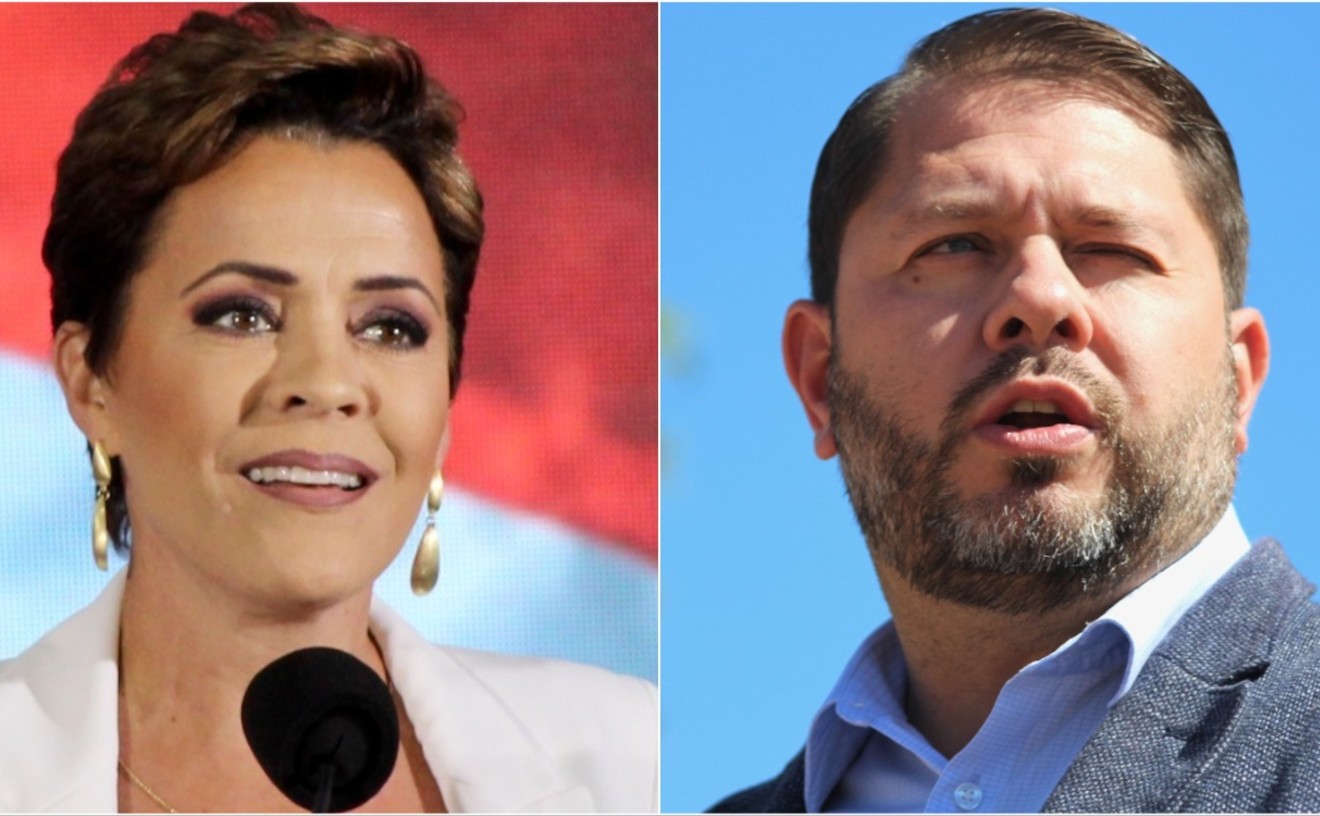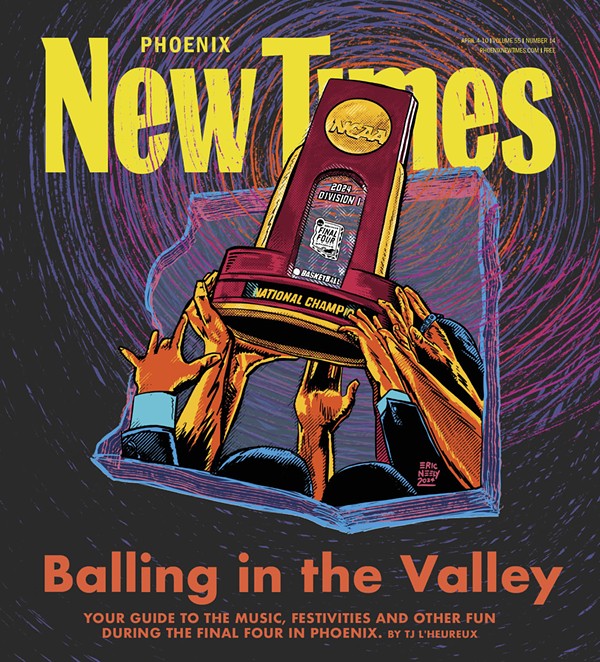As horn-emulating keyboards jaunt through the song, the singer clutches the microphone and sings, "Me name ah Casper Rastafari Native, mon."
The smell of marijuana, the holy sacrament of the Rastafari movement, permeates the smoky air. The slight Jamaican accent in the singer's voice sounds authentic, and the music is pure island groove, but this self-professed Rastafarian doesn't have the expected dreadlocks, but a short black mullet that barely reaches his shoulders. And he's not from the islands, but the desert of northern Arizona. He's not black, either, but he's sincere when he sings, "Fight for my people; my people not free."
The singer is Casper Lomayesva — Hopi reggae musician, budding political activist, and artist-advocate for Native American culture. At 5-foot-2, he hardly strikes an intimidating pose, but he's managed to do some very big things since taking up music 25 years ago. Most of them were "starving artist" years, but Lomayesva, now 42, has seen his career take off in the past several months.
Long after most people would have given up on "making it" in music to settle for day jobs that will actually pay the rent, Lomayesva has played some of the most famous venues in the country, including the Kennedy Center and Smithsonian in Washington. In May, he performed for more than 18,000 people at New York's Madison Square Garden as part of legendary folk singer Pete Seeger's 90th birthday celebration. From January until the end of September, he played Hard Rock Cafes all over the country as part of the Native Music Rocks tour.
Lomayesva's list of heroes puts Bob Marley, Peter Tosh, KRS-One, and Burning Spear alongside Geronimo, Sitting Bull, Crazy Horse, and late Hopi Chief Dan Katchongva. He says the Native American experience isn't that different from the African experience; both cultures have a history of oppression.
Indeed, when you hear Lomayesva talk about his music, the classic Bob Marley "Redemption Song" lyric comes to mind: "Won't you help to sing these songs of freedom? / 'Cause all I ever have / Redemption songs, redemption songs."
Because of this shared resistance to tyranny, the genre is wildly popular among Native Americans — from the Seminole Tribe of Florida, with its proximity to the Caribbean islands, to the Hopi of Arizona, who have a long history of bringing Jamaican reggae artists to the reservation, including Culture, whose singer Joseph Hill told the New York Times in 1999, "[Hopi] culture is quite specific and lonely in its own right . . . The black man suffered the same as the Hopi."
For all the Native reggae fans out there, Lomayesva is the only known Hopi reggae artist. But anybody expecting him to come out draped in turquoise and feathers is in for a letdown. Most of the time, Lomayesva's just wearing jeans and T-shirts. He lets his lyrics tell the stories and make the statements — as in the song "Jealousy," in which he sings:
"As long as I don't break no white law, I'll stay upon the top, not gonna take no fall / I never want to miss a day of freedom / This is my version of 'Redemption Song.'"
The view from atop any of the First through Third mesas on the Hopi Reservation in northern Arizona seems endless, with yawning blue sky meeting flat patches of brown dirt and rocky red earth in a still, panoramic sprawl.
Everything moves slowly here; even the breezes that roll across the mesas take their time circling in the dust. In the Hopi village of Old Oraibi, one of the country's oldest continuously occupied settlements, founded around 1100 on the Third Mesa, residents maintain 4,000-year-old traditions brought to the area by their ancestors.
The Hopi consider this place the center of the universe, and in a song called "Last Train," Casper Lomayesva says that "time always stands still in the center of the universe." But change, however slowly, has come to this place, and in Lomayesva's opinion, the best of it has come bouncing onto Hopi soil with rock-steady beats and Jamaican accents.
Next to country music, Lomayesva says, "reggae is the most in-demand on Indian land." It enjoys popularity on reservations nationwide, but particularly on the Hopi rez in Arizona.
The "Reggae Inna Hopiland" phenomenon started in 1984, when a group of fans on the Hopi Reservation tired of driving several hours to Phoenix and other Arizona cities to see reggae shows. They formed an organization called Culture Connection to bring reggae acts to the Hopi, starting with a Phoenix band, The Sons of Captivity.
Culture Connection founder Gerry Gordon, formerly a teacher at the Second Mesa Day School, says from 1984 until he left in 2000, there were "about 35 reggae shows" on the reservation, many featuring big names from the islands, including Toots and the Maytals, Steel Pulse, The Wailers, Black Uhuru, and Yellowman. Gordon says the shows drew anywhere from 750 to 2,000 people to the Hopi Civic Center. In the past two years, most of the late Bob Marley's sons, including Stephen, Damian, and Ziggy, have performed on or near Hopi land.
"When we brought Jamaican artists to the reservation, the artists really seemed to relate to the Hopi," Gordon says. "The Hopi women would cook them food, and we'd throw them in the back of a pickup truck — the 'Hopi limo,' we called it — and show them around the reservation. The Hopi would always present a gift to the artist on stage, like pottery or a kachina doll. Time slowed down. It was an interaction, as opposed to them playing at a bar."
The first Jamaican artists to perform on the reservation, Freddie McGregor and Michigan & Smiley, came in 1984. It was after seeing the latter act that Lomayesva, then 17, decided he wanted to make reggae music his life's work.
Like most reggae fans on the rez, Lomayesva grew up listening to reggae greats like Bob Marley and Peter Tosh on cassette and eight-track tapes, but it was the message of one of Michigan & Smiley's songs that made him want to write songs of his own.
"The song that struck me the most was called 'Diseases,' and they're talking about how, if you don't take care of yourself and you're being reckless with your sexual life, you can end up with diseases," Lomayesva says, before snapping his fingers and singing. "Mind Jah lick you with diseases / the most horrible diseases . . . And I was like, 'Hey, I like that.' It's just what they were representing. They were pushing the positive."
For Hopi reggae fans, there is a primal connection to the music, particularly to the rhythms. Reggae's springy, offbeat echoes and ancient drums ring true to the Hopi. "I've always been around powwow groups," Lomayesva says. "The beat of the drum radiates sound, which is the power."
There are many messages in reggae that resonate with Native Americans: resisting political oppression, displacement from homelands, poverty, praying for peace. In his song "Why?" Lomayesva sings, "Being a native and living in America / Is like being black living down in Africa."
"Sometimes, you'll listen to a reggae song, and they're singing about police brutality. Well, we can relate to that, because we've seen it," says Lomayesva, who has a song called "Rez Cop" on his 2004 album Honor the People. "Reggae is music of a struggling people . . . We, as Native people, have been struggling all these years. Everything that you hear in reggae music, we can relate to. It's the way it's delivered also. It's just so sweet and melodic. I could listen to a Bob Marley song as easy as I could listen to a powwow song."
Colin Leslie, a business associate of the late Bob Marley's and a marketing consultant for Tuff Gong records, the reggae label founded by Marley in 1970, talked about the connections between reggae and the Hopi people in a 2003 Jamaica Observer article: "Part of the impact Bob had, with respect to his work on Earth, was the rallying of indigenous peoples. I think immediately of the Hopi Indians."
Gerry Gordon recalls how a young Lomayesva would help Culture Connection set up for reggae shows by putting up signs, setting up stages, and, later, performing as an opening act for "a couple hundred bucks and gas money."
"Casper was sort of a natural progression of the fact that all these Jamaicans came to Hopiland to play," Gordon says. "Casper sings about the same things Marley did, but he sings about Native peoples."
When Lomayesva started writing songs himself, he would scribble his thoughts everywhere. "I used to write lyrics on everything," Lomayesva says. "Napkins, Kleenex boxes, rolls of toilet paper — they'd be lying everywhere with jargon written on them."
Growing up on the reservation, Lomayesva has witnessed divorces, custody and land disputes, deaths, and drug addictions, and has made his own missteps. He certainly has plenty of real-life experience to draw from.
"This is raw. This is real-life," Lomayesva says of his musical muses. "We don't want you mining uranium on Indian land. We don't want you stealing the water and the coal to light up Las Vegas. We don't want you bringing alcohol onto Indian land. These are the things we talk about. We want our kids to get an education, get off the rez, make a life for themselves, and maybe come back to the rez and do something for their communities."
The Hopi Reservation takes up 2,532 square miles and is surrounded by the Navajo Reservation, which is about 26,000 square miles. The Navajo is the largest Native American reservation in the United States, encompassing parts of New Mexico, Utah, and all of northeastern Arizona.
There's a wedge between the Navajo and the Hopi. The tribes have been involved in a complex land dispute since 1868, when the United States signed the Navajo Treaty and established the Navajo Reservation. The Hopi Reservation was established in 1882. Both tribes have sued each other several times in attempts to remain on or regain rights to land.
Casper Lomayesva's father is Hopi. His mother is Navajo. Growing up in the Hopi village of Kykotsmovi, he saw not only tribal tensions but a cultural schism between his parents. "I spent a lot of my youth in between different cultures and religions," he says. "Each one of those peoples has their own different medicine. How death is viewed by one tribe is completely different than the view of death of the next tribe. My father believed different things than my mother. Communication was rocky."
Asked how many siblings he has, Lomayesva closes his eyes and counts using his fingers. He calculates five sisters and five brothers (two of whom are deceased). His family home was full, he says, and full of tension, mainly because his father was an alcoholic. (Lomayesva says he has now rehabilitated, and the two have reconciled.)
Lomayesva's parents divorced before he became a teenager, and it wasn't pretty.
"I went back and forth between [Hopi and Navajo] reservations, and the tribes were bickering about land," he says. "When you had a custody battle out there, it usually involved federal marshals. And it did, in my case."
Lomayesva reacted by refusing to come home many nights. He says he had bouts with drinking. He was put on probation as an "incorrigible youth" and ultimately ended up at a group home in Tucson in a program called VisionQuest. Founded in Arizona in 1973, VisionQuest is an intervention for at-risk youth that provides services like counseling, sports, and job training. Lomayesva participated in the program from the ages of 12 to 16 and calls it "the best thing that ever happened to me.
"We did a wagon train — you know, pushing mules — with the idea that you can't con a donkey," he says with a laugh. "I also participated in a wilderness program, where we lived in tipis and did rope exercises. I rode a 10-speed bicycle from Tucson to St. Joe, Missouri."
Lomayesva attended public high school in Tucson, where he says he began writing and playing music as part of a hip-hop group that never went anywhere. It was his first time as an anomaly. "I was the only Native American in this school at the time, and then to be in a rap group?" Lomayesva says. "That was my first taste of organized chaos."
He graduated high school and tried to have a life off the reservation. He started attending college, but then his girlfriend got pregnant, so he quit school and took a job with an engineering firm in Mesa as a land surveyor, something he says he did off and on up until he got laid off eight months ago.
Lomayesva continued to attend reggae shows and make music while he helped raise two daughters, now ages 21 and 23. He has been married to a hospice nurse for the past decade, but in the early '90s, he was less settled, and his passion for the island sounds of reggae led him to make the first of three trips to Jamaica in 1991, when he was 25.
This was no swanky Caribbean getaway filled with resort amenities and white sandy beaches. Lomayesva says he spent his first month-long trip to Jamaica living in a tent he sent up in front of a friend's shanty. "I wanted to get the real-life, day-to-day experiences of the people," he says.
He would get up at dawn to help the family haul water uphill in five-gallon buckets so everybody could bathe, and he would make several trips a day. "People would see me carrying water — it was a village where I was staying. Eventually, they gave me a name: Warrior," Lomayesva says with a smile. "It was pretty cool. That was my first trip. You could just imagine the second and third time. It was like a homecoming."
In 1997, Lomayesva established his own record label, Third Mesa Music, and released his debut album, Original Landlord, under his Hopi name, Casper Loma-da-wa (loma dawa means "beautiful sun" in Hopi).
Lomayesva put together a backup band, which he christened The Mighty 602 Band, after the first area code he saw upon opening a metropolitan Phoenix phone book. As more gigs accumulated over the years, Lomayesva assembled a pool of talented players across the Southwest who could sit in with him, but the one constant has been bass player William "King Roach" Banks, who also plays bass for Valley reggae artist Walt Richardson.
Musically, the songs on Original Landlord reflect the reggae aesthetic — springy guitars, rock-steady beats, melodic keys — with splashes of soul, funk, and hip-hop. Lyrically, Lomayesva lets loose on corrupt justice systems, lack of education, and feelings of insignificance among Native peoples.
"To survive on the mesa you big up and be strong/The odds are against you when you fight the Babylon," Lomayesva sings on the title track.
In the song "Hundred Years of Redemption," he addresses the Hopi/Navajo land struggle: "The Hopi tribe upon reservation, in between Navajo occupation / There's speculation, of the situation / But still my people witness total annihilation / What we need is stronger education / to come together as the strongest Native nation."
Lomayesva has released two more albums on Third Mesa Music since his debut, The Sounds of Reality and Honor the People (both 2004). Each album reflects Lomayesva's love of all kinds of music — the foundation of every song is roots reggae, with Jamaican dance beats and spongy guitars — but he combines the island groove with elements like traditional native flutes ("Crossing the Borders") and tribal chants ("Don't Dem Know"). There's a heavy soul/R&B slant, too, especially on songs that feature the bluesy and powerful guest vocals of Phoenix reggae singer Sista Philly Blunt, like "Babylon World" and "Brother Leonard (Set Him Free)." The latter song, inspired by the imprisonment of American Indian Movement activist Leonard Peltier, includes a spirited, Southern gospel choir-type breakdown near the end.
In addition to his stable of solid backing players like bassist King Roach Banks, guitarist Roots, and drummer Vince Parker (also of Walt Richardson's Peaceful Warriors Band), Lomayesva's brought in some special guests for his albums. The Sounds of Reality includes contributions from British reggae singer Tippa Irie and Sioux author and poet John Trudell, while Honor the People features Phoenix DJ Element's turntable skills.
Eclectic contributions and sonic stews are exactly what Lomayesva wants. "People still have misconceptions and stereotypes," he says. "We played a music festival in downtown Boulder, Colorado, and it was called the Native American Music Festival. And some people were like, 'Is it powwow music? Where are the feathers?'
"We go beyond the beads and feathers," he continues. "This music that we do is from the same tree; it's just a different branch."
In Hopi culture, kachinas are supernatural beings who represent everything from animals to the stars to crops. But, essentially, they are thought to be the spirits of dead ancestors who visit the Hopi mesas in the form of rain clouds. Here, water is a communion with and a blessing from the spirit world. It features prominently in numerous Hopi ceremonies and rituals.
"The Hopis pray all four seasons — not for themselves, but for the world," Casper Lomayesva says. "They pray that we will have no war and that everybody will have food and water."
There is perhaps nothing more vital to life and sacred to the Hopi than water. But many say the springs no longer spring, that the ground-water supply is depleted by corporate mining on Native land. Lomayesva is passionate about the issue and has become an advocate and activist for water-reclamation rights on the Hopi Reservation.
A little background: In December 2008, the U.S. government's Office of Surface Mining granted a life-of-mine permit to Peabody Energy, which mined coal at Black Mesa Mine on joint Hopi and Navajo land from 1968 to 2005, when the Clean Air Act shut down the mine. The mine used a potable water source to pump coal through a 273-mile slurry pipe to a generating station in Laughlin, Nevada.
The OSM permit essentially allows Peabody to resume mining on Black Mesa until the coal is gone and to continue using water from the Navajo Aquifer to transport it.
Lomayesva's "pissed off" about this. He's an active supporter of the Sierra Club and the Black Mesa Water Coalition, both of which contacted the Interior Office of Hearings and Appeals and requested a review of the extended OSM permit, citing legal and environmental concerns.
"We have to pay for coal in the winter — and it's our coal!" Lomayesva says. "Ripping off Native peoples is alive and kicking still today, trust me. You don't have to be in Alaska; they're doing it right here in Arizona."
In a May 29 petition, the Hopi Tribe Office of the General Counsel asked the Department of the Interior Office of Hearings and Appeals to intervene in the review request filed by the Black Mesa Water Coalition and others, alleging that "the Hopi Tribe can little afford the loss of the vital revenues . . . produced for the tribe" by the mining operations.
Lomayesva argues that choosing "vital revenue" over sacred water is outrageous. "We're getting pennies, 15 cents for a gallon of water," he says. "This water's 1,000 years old. It's the most pristine water on Earth. Not only can you drink it, but when you bathe in it, it's like you can't get the soap off — it's that soft. But my suggestion is this: If we're going to give away our soul, why not bottle the shit and sell pristine water to people?
"The example I tried to give the counsel was, when you go to the store to buy a gallon of water, you're paying about $1.60 for it," he continues, "but you're selling the most pristine water in the world to these sharks who don't give a shit about you people! It makes me so mad, because we're so ignorant. Think of this: America's had a government for what, 200 years? The Hopis have only had one for 40. So we don't know how to govern ourselves."
Lomayesva's often told he should run for office in the Hopi tribal government because of his passion about the issues. "It is a joke to me, but more and more people are starting to say, 'That's something you should really think about, Casper,'" he says. "But I'm not a politician."
Yet he has become a role model for young Native Americans and is often invited to perform and speak at their schools across the country. So while he sings about the issues in his homeland, Lomayesva is also addressing universal problems and trying to present a positive message of peace and unity. He says that is the ultimate underlying message of reggae, after all: "One love." He is on a mission to lift spirits, especially on the Hopi Reservation, where he says suicides are common.
"I had a friend who was a kachina maker, and he killed himself for nothing," Lomayesva says. "His kachina dolls were selling for $10,000 each, and one night he got drunk and got into an argument with his wife, and he went up into the attic and shot himself in the head. Just like that. We didn't even know he was dead up there for two days."
On his album Honor the People, there's a song Lomayesva wrote about his friend's death called "Love Life." In it, he sings, "Well, now that you're gone, it's become our problem / And friends and relatives, yes, you involve them / And all of them are asking me the same question / Who will care for his wife and his four children?"
In the past 10 years, Lomayesva says, a new word appeared on the Hopi Reservation: murder. Alcoholism and suicide among Hopi people were not uncommon, but until recently, he says, "Homicide was unprecedented. For one Hopi to murder another was unheard of."
It's something Lomayesva's seen firsthand. While he rehearses with the 602 Band on a sunny September day in Phoenix, there's a murder trial on the Hopi Reservation. The man on trial is accused of beating Casper's brother, Isaac Lomayesva, to death in March. "My younger brother was a product of the drug and alcohol problems," Lomayesva says. "He was beaten to death while partying with people. And the worst part is, there's a connection. We know the [accused] murderer's family."
Tragically, it was the second time Lomayesva watched someone he grew up with go on trial for murdering a brother. Claybourn Lomayesva was also beaten to death by someone from his village in an alcohol-related incident a few years ago. The killer was sentenced to four years in prison.
"The worst part is the way the murders happen. The best way I can describe it is, there's a reason we were called savages," Lomayesva says. "The beatings are so bad you can't even recognize the body. How could one Hopi do that to another?
"Native peoples are needed, and we need to change the mentality that we're insignificant," Lomayesva says. "Why not try to uplift yourself: mentally, spiritually, physically? The idea is simple: We are worthy of life."
When representatives of legendary folk singer Pete Seeger called Casper Lomayesva to tell him that Seeger wanted him to perform at his 90th birthday celebration at Madison Square Garden in May, Lomayesva had no idea who Seeger was.
Seeger, composer of such American standards as "Turn, Turn, Turn!" and "If I Had a Hammer (The Hammer Song)," wanted a dozen Native American artists to appear with him as the Native American Cultural Alliance, and Lomayesva was one of them. (Others included Iroquois author and activist Oren Lyons, Cheyenne flautist Joseph Fire Crow, and R. Carlos Nakai, a Navajo/Ute flautist from Flagstaff.)
Lomayesva called his friends and excitedly told them he had been booked to play the Garden for Bob Seger's 90th birthday. He quickly realized that his host was not the much younger "Old Time Rock and Roll" singer, but someone of greater influence.
Dubbed "The Clearwater Concert," the event took place Sunday, May 3, and was both a celebration for Seeger and a benefit for environmental advocacy organization Hudson River Sloop Clearwater. More than 40 artists performed, including Bruce Springsteen, Dave Matthews, John Mellencamp, Arlo Guthrie, Emmylou Harris, and Ben Harper.
Lomayesva found himself rubbing elbows backstage with the likes of Kris Kristofferson and Susan Sarandon, and performing onstage to more than 18,000 people. It was a big moment for him, but just one of his notable achievements in recent years.
He's played the annual New Orleans Jazz and Heritage Festival twice (in 2002 and 2008), and as a representative of cultural diversity and indigenous peoples, Lomayesva's played at many events in D.C. He kicked off the Smithsonian's American Indian Heritage Month in November 2003 with a reggae concert at the National Museum of Natural History. In 2005, Lomayesva performed at the Kennedy Center's 21st Annual Open House Arts Festival. He also participated in George W. Bush's and Barack Obama's Presidential Inaugural Celebrations but never met either.
"All these political organizations have their interest groups, so when there's a new president, they all put together some sort of a galleria thing, and Native America was part of that," Lomayesva says. "There were a lot of tribal chairmen and bigwigs from Indian country at the show, but President Obama didn't come. It wasn't scheduled or anything. There were, like, 400 balls for him that night."
His playing at Bush's inauguration did not sit well among some of his music contemporaries. "I got a lot of flak from the reggae community for playing Bush's inaugural celebration because of what this president represented," Lomayesva says. "My thinking was: We were asked to do this for Native America. I'm representing Native America. Whether I like the guy or not is irrelevant. But some DJs refused to play my music. The reggae community's small, and some people were like, 'How dare this Native American guy do this celebration for this new president!'
"I didn't respond to a single one of those angry e-mails," he continues. "I just let them voice their opinion. That's what we represent — free speech."
Casper & The Mighty 602 Band have opened for international acts like Ziggy Marley and Michael Franti & Spearhead at the Pine Mountain Amphitheatre in Flagstaff. Lomayesva's even mentioned in two college textbooks: Who Owns Native Culture? (Harvard University Press, 2004), and Ethnomusicology: A Contemporary Reader (Routledge, 2005).
For most of 2009, Lomayesva's been touring Hard Rock Cafes all over the country with Native Music Rocks, a music festival sponsored by the Seminole Tribe of Florida, which owns the Hard Rock chain worldwide (but not the Las Vegas location). Lomayesva was chosen to join such Native artists as Grammy Award-winner Micki Free and RCA Nashville recording artist Crystal Shawanda because of his message, according to Tina Osceola, chief historic resources officer for the Seminole Tribe of Florida.
"It's his political and social message," Osceola says. "It's not just about partying and listening to good music — which is what ends up happening when you see Casper — but if you listen to his message, you'll learn a lot not only about Hopi people but Native Americans in general. I think Casper's doing the same thing for his people that Bob Marley did for his."
"He's a role model for others. I have a 10-year-old son who has to listen to Casper's CDs every morning on the way to school," Osceola adds. "I think reggae gives kids a purpose. The message is a positive one — it's about peace and life."
Though his albums can be found only at live shows and at Drumbeat Indian Arts, off 16th Street and Indian School Road in Phoenix, Lomayesva says he is making a good living touring and playing live — at Valley shows, regional reggae festivals, and reservations and casinos all over the United States. And he's got other opportunities on the horizon.
First, he plans to spend the entire month of October recording songs for his as-yet-untitled fourth album. His label, Third Mesa Music, is also scheduled to release a solo CD by his bass player, King Roach Banks, by the end of this year.
Third Mesa Music has grown from a hobby into a thriving business, and Lomayesva has had to hire an accountant and get incorporated. "I'll admit it — I've been audited by the IRS twice," Lomayesva says. "After that, I wasn't gonna mess around. Like my accountant told me, 'This is not a hobby anymore, Casper, it's a business. Treat it as such.'"
He has never had a manager, so all the details of touring — booking shows, flights, rental cars, hotel rooms — fall to him. He also has to make sure his band members get paid. "It's too much, sometimes," Lomayesva says. "The work has been coming so fast lately that I almost can't keep up. That's never happened before."
Lomayesva frequently returns to his childhood home on the Hopi reservation to perform and speak to students at Hopi High School.
"Casper's vocal against crime and problems on the reservations, and trying to push youth in a more positive direction," says Macadio Namoki, development and marketing coordinator for Hopi Radio (KUYI 88.1 FM). "He's also an advocate for keeping our traditions and our language. We really support his work. Whenever he comes out with something new, we feature it."
Namoki says Lomayesva has also supported Hopi Radio, which has a weekly reggae show on Thursday nights. When Lomayesva played at Madison Square Garden this past spring, he handed out promotional materials for the nine-year-old station. "Casper's a really fine artist," Namoki says. "A lot of youth here look up to him because they see what he's accomplished."
Casper Lomayesva is all business on a sweltering afternoon in mid-September; he's rehearsing with a new keyboard player at Perfect Timing Entertainment on Seventh Street and Pierce. It is the first time this musician has played with Lomayesva's band, and he is dripping sweat while he goes over and over the melody on one of Lomayesva's new songs.
The song is called "Serious Man," a slow-tempo roots reggae number bolstered by three-part vocal harmony and melancholy organ. Lomayesva says he wrote the song for his mother. The chorus goes like this: "Mama, I'm a serious, serious man / Not gonna joke with no heathen / Mama, I'm a serious, serious man / And I won't play with policeman."
"Serious Man" is a reflection of Lomayesva's growth as an artist and a person. He could not have written it 30 years ago, when he was an "incorrigible youth" from a broken home on the rez.
"I wanted to tell my mom I'm serious about living now," he says. "I'm not treating my life like a joke anymore."


